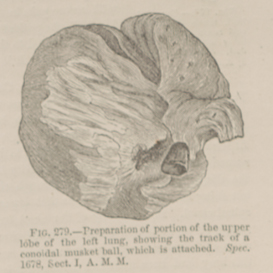Title: Clark, Thomas
Source text: Surgeon General Joseph K. Barnes, United States Army, The Medical and Surgical History of the War of the Rebellion. (1861–65.), Part 1, Volume 2 (Washington, D.C.: Government Printing Office, 1870), 583.
Civil War Washington ID: med.d1e20257
TEI/XML: med.d1e20257.xml
CASE 6.—Sergeant Thomas Clark, Co. I, 1st United States Cavalry, was struck by a carbine ball in the cavalry fight near Brandy Station, Virginia, August 1st, 1863. On the next day he was admitted to Douglas Hospital, Washington. When admitted, the bullet was discovered beneath the integument, below the inferior angle of the left scapula, whence it was removed by Acting Assistant Surgeon J. E. Smith. The wound of entrance was found anteriorly over the third rib, which had been fractured. This case was diagnosed as a penetrating wound of the left thoracic cavity, involving the upper lobe of the lung. There had been hæmoptysis and dyspnœa, and there was when admitted great prostration. The clinical history of the case is very imperfect. On the 7th, the patient was found almost in articulo mortis, and fully comprehended the situation; but after a consultation it was concluded that no operation at that period would be of avail. The effusion had almost filled the left side, and was causing dyspnœa and profound depression, and at 11 A. M. death took place. Previous to the autopsy, a trocar was introduced below the angle of the scapula, between the eleventh and twelfth ribs, and evacuated half a gallon of bloody serum. On examining the lungs, the track of the bullet was found lined with spiculæ of bone from the comminuted rib. There was local pneumonia of the upper lobe, with the usual evidence of pleuritis; copious effusion of serum, and extensive exudations of lymph. No other lesions were discovered, and death occurred from the traumatic pleuritis and its consequent effusion. The accompanying wood cut (FIG. 279) gives some idea of the course of the ball. It was drawn from a wet preparation forwarded to the Museum by Assistant Surgeon W. Thomson, U. S. A., then in charge of Douglas Hospital.
